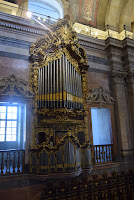Because my flight to Liverpool was early in the afternoon I decided to take advantage of the free morning and the proximity of the Clérigos Tower and venture myself in its secrecies.
I had no idea the whole ensemble was connected to the Brotherhood of Clérigos said to have been born in 1707 so as to carry out works of charity and mercy. Its 75 metre Tower used to serve as a guiding reference for the boats sailing the river Douro and was equipped with a commercial telegraph, being a strategic point for military fighting. I did climb its step spiral staircase, from which I took one single picture, as I personally fear the height.

I then made my way into the several exhibit rooms which displayed several Art, furniture, jewellery and religious apparel collections, as I headed to the upper choirs and finally the Church. The first room I walked into was the Assembly room where decisions were taken by the Brotherhood board members. On the east side one could see an altarpiece with the image of the patron Saint, Our Lady of the Assumption, as well as some portraits of the main benefactors of the Brotherhood.


I then walked into the Registry and Archive Room before having found myself at the Upper Choir once solely used by the singers and the clergy. From it I could have a tremendous view over the Church.







Before I reached the actual Church I still strolled around an exhibit room filled with Portuguese, Spanish and other Iberian crafsmanship pieces, mainly wooden sculptures, paintings and votive canvases, which I took some pictures of.


Judas' kiss - 17th-18th century (left) and Virgin of Piety - 16th-17th century (right).


Jesus tied to the column - 18th century (left). Ecce Homo - 17th century (right).

I couldn't help photographing some portable oratories dating back to the 17th century, which I found to be interesting, not to say practical.
The moment I reached the main elliptical nave of the Church I was mesmerised by Nicolau Nasoni's artistry as I looked at the polychrome marble throne crowned by the statue of the patron Saint. Nasoni is known for having brilliantly combined granite, marble adn gold carving, having turned the Church of Clérigos into one of the nicest Baroque Temples acknowledged as the crowning jewel of Porto.




(To be continued)





















No comments:
Post a Comment